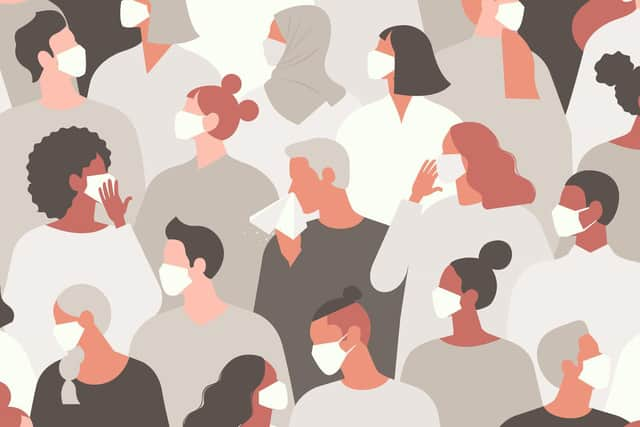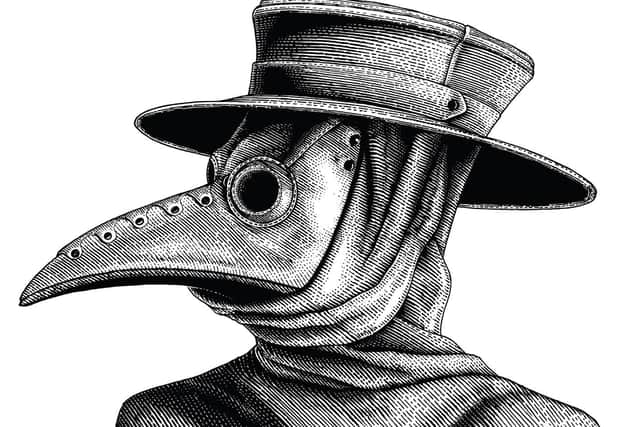How using face masks as PPE goes back centuries
It’s difficult to identify a starting point for masks, but the concept of face coverings as PPE has been important – and occasionally contentious – for generations.
In ancient Rome noted naturalist Pliny the Elder suggested using animal bladders to fashion face masks for miners exposed to poisonous lead oxide. Fast forward 1500 years, and Leonardo da Vinci recommended placing a wet cloth over nose and mouth to protect against chemical warfare.
Advertisement
Hide AdAdvertisement
Hide AdPerhaps history’s most recognisable medical masks belonged to the so-called ‘plague doctors’ of 17th and 18th century Europe, whose beak-like face furniture would fit as well in a modern horror flick as an historic hospital.


Contemporary wisdom held that diseases were spread via ‘miasma’ – noxious, airborne substances emitted by rotting matter – so the beaks would often be packed with aromatic spices and herbs. The theory was flawed, but the masks probably did afford protection to the wearers, if only by being a barrier.
The first crude respirators emerged in the late 18th and early 19th centuries, mostly bags fastened over the head, with windows to see through.
Exact provenance is debated, but Scottish chemist John Stenhouse can probably claim the first filter face mask. His invention, of the early 1850s, used charcoal to absorb poisonous gases in the air – and with its ear straps and snug fit over the nose and mouth, looked remarkably similar to the N95 masks used by health workers today.


Advertisement
Hide AdAdvertisement
Hide AdAs the 20th century loomed, and germs replaced miasma at the centre of disease prevention, cloth masks became increasingly common among surgeons and doctors in Europe and America. But it would take a pandemic for them to break into the mainstream.
The Spanish Flu pandemic – of 1918-20, and among the deadliest in history – crystallised the importance of face masks in countries across the world.
In the United States, the Red Cross ran a public safety announcement warning that “the man or woman or child who will not wear a mask now is a dangerous slacker”, and public mask-wearing was briefly made mandatory in California.
San Francisco became an intriguing case study, both for contemporary scientists and modern historians. While the First World War still raged, the populace viewed masks as patriotic, and adherence was generally high.
Advertisement
Hide AdAdvertisement
Hide AdOnce the war ended, however, enthusiasm for masks collapsed, public officials were photographed with bare faces, and around 2,000 dissidents formed the so-called “Anti-Mask League“. The city went on to experience a severe second wave of Spanish Flu.
In the UK, masks were merely advised, and disinformation abounded. In October 1918, MP Colonel Lowther MP asked the House of Commons, “Is it a fact that a sure preventative against influenza is cocoa taken three times a day?” Meanwhile, the News of the World’s advice to its readers included instructions to “force yourself to sneeze night and morning” and “eat plenty of porridge”.
In other parts of the world, it was a different story. Masks were already in vogue in China following a plague epidemic in 1910-11, while the Japanese public took to mask-wearing as a civic duty. Throw in the more recent SARS and MERS pandemics, and the East Asian affinity for mask-wearing has been strong for quite some time.
World War Two brought another wave of face mask wearing, as the British government ordered the distribution of 500,000 units to stop packed air raid shelters and tube stations becoming easy prey for flu season. The season was light, the masks mostly unneeded, but they featured in government propaganda as part of the “blitz spirit”.
Advertisement
Hide AdAdvertisement
Hide AdThe 1960s revolutionised masks once again, with the invention of single-use models. Along with single-use gloves, syringes and more, the masks made up part of what one hospital administrator in 1969 called a “a total disposable system”.
Now Covid-19 has brought back reusable masks for the wider population – as eco-friendly, do-it-yourself alternatives to mass production, supported by online sewing tutorials.
Editor’s note: first and foremost - and rarely have I written down these words with more sincerity - I hope this finds you well.
Almost certainly you are here because you value the quality and the integrity of the journalism produced by The Yorkshire Post’s journalists - almost all of which live alongside you in Yorkshire, spending the wages they earn with Yorkshire businesses - who last year took this title to the industry watchdog’s Most Trusted Newspaper in Britain accolade.
Advertisement
Hide AdAdvertisement
Hide AdAnd that is why I must make an urgent request of you: as advertising revenue declines, your support becomes evermore crucial to the maintenance of the journalistic standards expected of The Yorkshire Post. If you can, safely, please buy a paper or take up a subscription. We want to continue to make you proud of Yorkshire’s National Newspaper but we are going to need your help.
Postal subscription copies can be ordered by calling 0330 4030066 or by emailing [email protected]. Vouchers, to be exchanged at retail sales outlets - our newsagents need you, too - can be subscribed to by contacting subscriptions on 0330 1235950 or by visiting www.localsubsplus.co.uk where you should select The Yorkshire Post from the list of titles available.
If you want to help right now, download our tablet app from the App / Play Stores. Every contribution you make helps to provide this county with the best regional journalism in the country.
Sincerely. Thank you.
James Mitchinson